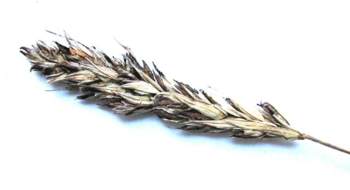Diseases
Tilletia secalis (Cda.) Koern. - Bunt of Rye.
Systematic position.
Class Basidiomycetes, subclass Teliobasidiomycetidae (= Sclerobasidiomycetidae), oder Ustilaginales, family Tilletiaceae, genus Tilletia.Biological group.
Biotroph.Morphology and biology.
Tilletia secalis infects species of Secale, Taeniatherum and Elymus. Disease is apparent at stages of milk or early dough development. Heads may look blue-green, and glumes may spread apart in the infected head. Awns may be reduced. Later the color of infected and non infected heads becomes nearly the same. Infected heads may be wholly or partially smutted. In colonized heads the olive-brown mass of bunt balls is covered with a membrane that remains intact. When those balls rupture, the spore mass has a distinctive fishy odor. Teliospores from smutted heads may be released by harvesting operations, mixing with seeds in the harvester. The fungus keeps as teliospores on seed surface. On the soil the spores lose germinating capacity rapidly. The germinating spores infect young seedlings. Then the pathogen develops in plant meristem, ultimately invading and replacing the ovary tissues. Spores are dark brown, surrounded with jelly-like layer, spherical or oval, 18.7 - 26.3 mkm in diameter with reticular surface; cells are 1.5 - 2.5 mkm in height and 2.5 mkm in width.Distribution.
Disease is distributed almost in all countries of Europe, in USA, Argentina, Turkey. It is considered that in Russia the disease is distributed everywhere. Practically the disease is found everywhere where the rye is grown, sometimes causing strong damage. In this case to 50-70% of plants may be infected. Last years the Bunt epiphytoties have became rare in connection with agronomical improvements.Ecology.
T. secalis spores germination and host infection demands the lowered temperature. The infection occurs best of all at temperature 2.C, whereas the temperature 12.C is too high for T. secalis.Economic significance.
Disease is potentially dangerous because its epiphytoties may be observed at regular intervals. In this case the damage is appreciable, consisting both of direct losses and losses connected with depression of outwardly healthy plants. Control measures include seeds treatment and use of mineral fertilizers according to agrochemical analysis of the soil.Related references:
Anon. 1999. Smuts of rye, oats and barley. Zashchita rastenii i karantin 7: p. 31 (in Russian).Ishkova, T.I., Berestetskaya, L.I., Gasich, E.L., Levitin, M.M. & Vlasov, D.Yu. 2002. Diagnostics of the main fungus diseases of cereal crops. St. Petersburg: VIZR. 76 p. (in Russian).
Karatygin, I.V. 1986. Smuts of cereal crops. Leningrad: Nauka. 112 p. (in Russian).
Levitin, M.M. & Tyuterev, S.L. 2003. Fungal diseases of cereals crops. Zashchita rastenii i karantin 11: 77 (in Russian).
© Dmitriev A.P.


